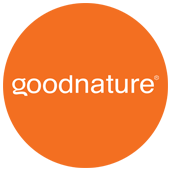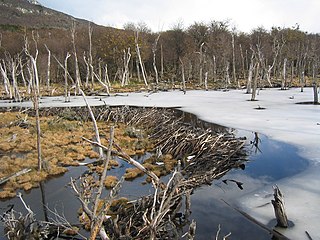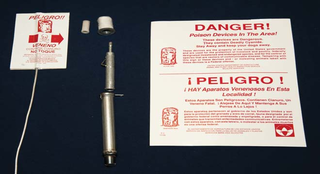 W
WPest control is the regulation or management of a species defined as a pest, a member of the animal kingdom that impacts adversely on human activities. The human response depends on the importance of the damage done and will range from tolerance, through deterrence and management, to attempts to completely eradicate the pest. Pest control measures may be performed as part of an integrated pest management strategy.
 W
WBilly the Exterminator is an American reality television series which aired on the A&E network.
 W
WGoodnature is a New Zealand manufacturer of lethal traps for animals such as stoats, rats, mice and possums. It was founded by Robbie van Dam and Craig Bond in 2005, and sells automatic self-resetting pest control traps and accessories.
 W
WThe International Plant Protection Convention (IPPC) is a 1951 multilateral treaty overseen by the Food and Agriculture Organization that aims to secure coordinated, effective action to prevent and to control the introduction and spread of pests of plants and plant products. The Convention extends beyond the protection of cultivated plants to the protection of natural flora and plant products. It also takes into consideration both direct and indirect damage by pests, so it includes weeds.
 W
WAn invasive species is most often a non-native species that spreads from a point of introduction to become naturalized and negatively alters its new environment. Although their spread can have beneficial aspects, invasive species adversely affect the invaded habitats and bioregions, causing ecological, environmental, and/or economic damage. Sometimes the term is used for native species that invade human habitats and become invasive pests. In the 21st century they have become a serious economic, social, and environmental threat.
 W
WThe M44 cyanide device is used for the killing of coyotes, feral dogs, and foxes. It is made from four parts: a capsule holder wrapped with cloth or other soft material, a small plastic capsule containing 0.88 grams of sodium cyanide, a spring-powered ejector, and a 5-7 inch stake. To install the trap, the stake is first driven down into the ground, and then the capsule is put in the holder, screwed onto the cocked ejector, and secured to the stake. The wrapped capsule holder is smeared with scented bait to attract coyotes and make them bite and pull on it. When the trap is triggered, the spring propels a dose of sodium cyanide into the animals's mouth, and the sodium cyanide combines with water in the mouth to produce poisonous cyanide gas. In addition to the cyanide, the capsule contains Day-Glo fluorescent particle marker.
 W
WThe National Pest Management Association (NPMA), is a non-profit trade association founded in 1933 that represents the interests of the professional pest management industry and pest control professionals in the United States.
 W
WThe nematodes or roundworms constitute the phylum Nematoda, with plant-parasitic nematodes being known as eelworms. They are a diverse animal phylum inhabiting a broad range of environments. Taxonomically, they are classified along with insects and other moulting animals in the clade Ecdysozoa, and unlike flatworms, have tubular digestive systems with openings at both ends. Like tardigrades they have a reduced number of Hox genes, but as their sister phylum Nematomorpha has kept the ancestral protostome Hox genotype, it shows that the reduction has occurred within the nematode phylum.
 W
WA quarantine is a restriction on the movement of people and goods which is intended to prevent the spread of disease or pests. It is often used in connection to disease and illness, preventing the movement of those who may have been exposed to a communicable disease, but do not have a confirmed medical diagnosis. It is distinct from medical isolation, in which those confirmed to be infected with a communicable disease are isolated from the healthy population. Quarantine considerations are often one aspect of border control.
 W
WPhenothrin, also called sumithrin and d-phenothrin, is a synthetic pyrethroid that kills adult fleas and ticks. It has also been used to kill head lice in humans. d-Phenothrin is used as a component of aerosol insecticides for domestic use. It is often used with methoprene, an insect growth regulator that interrupts the insect's biological lifecycle by killing the eggs. Phenothrin is the active agent in the branded product Raid Fly and Wasp Killer.
 W
WRemote control animals are animals that are controlled remotely by humans. Some applications require electrodes to be implanted in the animal's nervous system connected to a receiver which is usually carried on the animal's back. The animals are controlled by the use of radio signals. The electrodes do not move the animal directly, as if controlling a robot; rather, they signal a direction or action desired by the human operator and then stimulate the animal's reward centres if the animal complies. These are sometimes called bio-robots or robo-animals. They can be considered to be cyborgs as they combine electronic devices with an organic life form. Because of the surgery required, and the moral and ethical issues involved, there has been criticism aimed at the use of remote control animals, especially regarding animal welfare and animal rights. A similar, non-invasive application has been reported which stimulates the brain with ultrasound to control the animal. Some applications use vibrations or sound to control the movements of the animals.
 W
WA smother crop is a thick, rapidly growing crop that is used to suppress or stop the growth of weeds. Smother crops have better root systems that help them compete with weeds for water, and as a result the root systems of weeds get weak. Meanwhile, the dense top growth of the smother crop suppresses the top growth of weeds. Effectively, smother crops successfully compete with weeds for vital resources and inhibit their germination and growth. Once the smother crop has served its purpose, it is ploughed under along with the weakened weeds, thus providing green fertilizer. A good smother crop must compete strongly with weeds but minimally with the crop. Smother crops reduce dependence on chemical weed control, and are sometimes used in the transition to organic farming.
 W
WTrophobiosis is a symbiotic association between organisms where food is obtained or provided. The provider of food in the association is referred to as a trophobiont. The name is derived from the Greek τροφή trophē, meaning "nourishment" and -βίωσις -biosis which is short for the English symbiosis.
 W
WWeed control is the botanical component of pest control, which attempts to stop weeds, especially noxious weeds, from competing with desired flora and fauna including domesticated plants and livestock, and in natural settings preventing non native species competing with native species.
 W
W